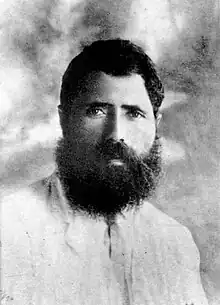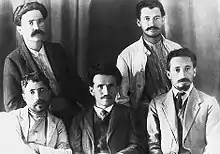Yosef Haim Brenner | |
|---|---|
 Brenner in 1910 | |
| Born | 11 September 1881 Novi Mlyny, Russian Empire |
| Died | 2 May 1921 (aged 39) Jaffa, Mandatory Palestine |
| Language | Hebrew |
| Spouse |
Chaya Braude (m. 1913) |
Yosef Haim Brenner (Hebrew: יוֹסֵף חַיִּים בְּרֶנֶר, romanized: Yosef Ḥayyim Brener; 11 September 1881 – 2 May 1921) was a Hebrew-language author from the Russian Empire, and one of the pioneers of modern Hebrew literature.
Biography

Yosef Haim Brenner was born to a poor Jewish family in Novi Mlyny, Russian Empire (today part of Ukraine). He studied at a yeshiva in Pochep, and published his first story, Pat Lechem ("A Loaf of Bread") in Ha-Melitz in 1900, followed by a collection of short stories in 1901.[1]
In 1902, Brenner was drafted into the Russian army. Two years later, when the Russo-Japanese War broke out, he deserted. He was initially captured, but escaped to London with the help of the General Jewish Labor Bund, which he had joined as a youth.
In 1905, he met the Yiddish writer Lamed Shapiro. Brenner lived in an apartment in Whitechapel, which doubled as an office for HaMe'orer, a Hebrew periodical that he edited and published in 1906–07. In 1922, Asher Beilin published Brenner in London about this period in Brenner's life.
In 1913, Brenner married Chaya Braude, with whom he had a son, Uri.[2]
Brenner immigrated to Palestine (then part of the Ottoman Empire) in 1909. He worked as a farmer, eager to put his Zionist ideology into practice. Unlike A. D. Gordon, however, he could not take the strain of manual labor, and soon left to devote himself to literature and teaching at the Gymnasia Herzliya in Tel Aviv. According to biographer Anita Shapira, he suffered from depression and problems of sexual identity.[2] He was murdered in Jaffa in May 1921 during the Jaffa riots.
Zionist views
In his writing, Brenner praised the Zionist endeavor, but also contradicted himself, contending that the Land of Israel was just another diaspora and no different from other diasporas.[2]
Writing style
Brenner was very much an "experimental" writer, both in his use of language and in literary form. With Modern Hebrew still in its infancy, Brenner improvised with an intriguing mixture of Hebrew, Aramaic, Yiddish, English and Arabic. In his attempt to portray life realistically, his work is full of emotive punctuation and ellipses. Robert Alter, in the collection Modern Hebrew Literature, writes that Brenner "had little patience for the aesthetic dimension of imaginative fictions: 'A single particle of truth,' he once said, 'is more valuable to me than all possible poetry.'" Brenner "wants the brutally depressing facts to speak for themselves, without any authorial intervention or literary heightening."[3] This was Alter's preface to Brenner's story, "The Way Out", published in 1919, and set during Turkish and British struggles over Palestine in World War I.
Commemoration
The site of his murder on Kibbutz Galuyot street is now marked by Brenner House, a center for Hanoar Haoved Vehalomed, the youth organization of the Histadrut. Kibbutz Givat Brenner was also named for him, while kibbutz Revivim was named in honor of his magazine. The Brenner Prize, one of Israel's top literary awards, is named for him.[4]
Published works
- Me-ʻemek ʻakhor: tsiyurim u-reshimot [Out of a Gloomy Valley]. Warsaw: Tushiyah. 1900. A collection of 6 short stories about Jewish life in the diaspora.
- Ba-ḥoref [In Winter] (novel). Ha-Shilo'aḥ. 1904.
- Yiddish: Warsaw, Literarisher Bleter, 1936.
- Mi-saviv la-nekudah [Around the Point] (novel). Ha-Shilo'aḥ. 1904.
- Yiddish: Berlin, Yiddisher Literarisher Ferlag, 1923.
- Me'ever la-gvulin [Beyond the Border] (play). London: Y. Groditzky. 1907.
- Min ha-metzar [Out of the Depths] (novella). Ha-Olam. 1908–1909.
- Bein mayim le-mayim [Between Water and Water] (novella). Warsaw: Sifrut. 1909.
- Kitve Y. Ḥ. Brenner [Collected Works]. Kruglyiakov. 1909.
- Atzabim [Nerves] (novella). Lvov: Shalekhet. 1910.
- English: In Eight Great Hebrew Short Novels, New York, New American Library, 1983.
- Spanish: In Ocho Obras Maestras de la Narrativa Hebrea, Barcelona, Riopiedras, 1989.
- French: Paris, Intertextes, 1989; Paris, Noel Blandin, 1991.
- Mi-kan u-mi-kan: shesh maḥbarot u-miluʼim [From Here and There] (novel). Warsaw: Sifrut. 1911.
- Sipurim [Stories]. Sifriyah ʻamamit ;no.9. New York: Kadimah. 1917. hdl:2027/uc1.aa0012503777.
- Shekhol ve-khishalon; o, sefer ha-hitlabtut [Breakdown and Bereavement] (novel). Hotsaʼat Shtibel. 1920.
- English: London, Cornell Univ. Press, 1971; Philadelphia, JPS, 1971; London, The Toby Press, 2004.[5]
- Chinese: Hefei, Anhui Literature and Art Publishing House, 1998.
- Kol kitve Y. Ḥ. Brenner [Collected Works of Y. H. Brenner]. Tel Aviv: Hotsaʼat Shtibel. 1924–30.
- Ketavim [Collected Works] (four volumes). Ha-kibutz ha-me’uhad. 1978–85.
- English: Colorado, Westview Press, 1992.
See also
References
- ↑ Shaked, Gershon (2007). "Brenner, Joseph Ḥayyim". In Berenbaum, Michael; Skolnik, Fred (eds.). Encyclopaedia Judaica. Vol. 4 (2nd ed.). Detroit: Macmillan Reference. p. 1347. ISBN 978-0-02-866097-4.
- 1 2 3 Golan, Avirama (2008-09-18). "The Case of Y. H. Brenner". Haaretz. Retrieved 2018-05-22.
- ↑ Alter, Robert (1975). Modern Hebrew Literature. New York: Berhman House. p. 141.
- ↑ Sela, Maya (14 April 2011). פרס ברנר יוענק השנה לסופר חיים באר [Brenner Prize awarded this year to writer Haim Beer]. Haaretz (in Hebrew). Retrieved 16 April 2021.
- ↑ "Breakdown and Bereavement by Y. H. Brenner". The Toby Press. Archived from the original on July 17, 2012. Retrieved 2013-12-16.
Further reading
- Shapira, Anita (2014). Yosef Haim Brenner: A Life. Tr. Antony Berris. Stanford. California: Stanford University Press.
- Yosef Haim Brenner: A Biography (Brenner: Sippur hayim), Anita Shapira, Am Oved (in Hebrew)
- Yosef Haim Brenner: Background, David Patterson, Ariel: A Quarterly Review of Arts and Letters in Israel, vol. 33/34, 1973
External links
- Brenner's Hebrew works in Project Ben-Yehuda
- Institute for Translation of Hebrew Literature bio
- Works by or about Yosef Haim Brenner at Internet Archive
- Works by Yosef Haim Brenner at LibriVox (public domain audiobooks)
